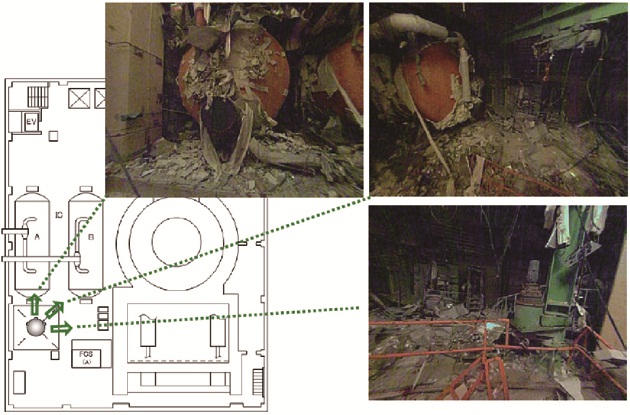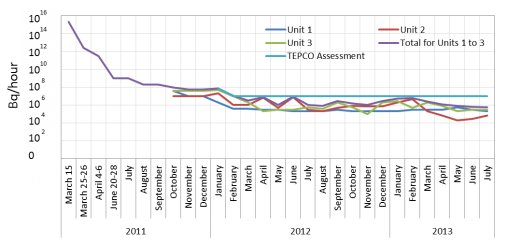Fukushima Daiichi Nuclear Power Station: Still too many unknowns about the accident and the current condition of the plant Nuke Info Tokyo No. 154
 |
| Figure 1. The inside of the fourth floor in Unit 1 filmed with the use of a balloon. (From TEPCO’s report released on August 8, 2012, titled “Results of investigation on the operating floor of Fukushima Daiichi Nuclear Power Station Unit 1”) |
One of Japan’s major newspapers, the Asahi Shimbun, reported on February 7 that Tokyo Electric Power Co. (TEPCO) had obstructed the investigation of the accident at Fukushima Daiichi Nuclear Power Station (FDNPS) by the National Diet of Japan Fukushima Nuclear Accident Independent Investigation Commission (NAIIC). TEPCO clearly gave commission members false explanations concerning the condition of the Unit 1 reactor building.
A group of NAIIC members led by Mitsuhiko Tanaka was in charge of the investigation into the causes of the nuclear accident, and this writer participated in the investigation as a collaborator. As part of the investigation, the group planned to inspect the plant reactor buildings. There were two primary objectives for the inspection, 1) to determine the source of the serious water leakage in Unit 1, which was witnessed by workers on the fourth floor of the reactor building in the wake of the Great East Japan Earthquake, and 2) to confirm the suspected damage of the pipes which were connected to the isolation condenser on the same floor.
Our perception was that we would be able to reach the site of the massive water leakage and conduct an inspection there, although it would be difficult to stay at the site for any length of time due to the extremely high dose rate. These assumptions were based on the air dose rate in the reactor building published on Dec. 3, 2011, and TEPCO’s video of this site released on October 21, 2011.
When TEPCO explained to us in the preparatory meeting that it was too dark to walk around inside the reactor building, we were therefore quite astonished.
Later, the Asahi Shimbun revealed that this explanation by TEPCO was totally untrue.
In the end, the NAIIC group was unable to conduct an inspection inside Unit 1 reactor building, and the two questions that were to be resolved by the inspection remained unanswered. We suspect that there was something on the fourth floor of the building which TEPCO wanted to conceal if at all possible. Although TEPCO refused to guide us to the site, the utility staff is said to have visited the site a number of times, and on February 15 this year released the video it took at the site on November 30, 2012
In the report on the results of the inspection conducted at that time, TEPCO referred to the cause of the water leakage on the fourth floor of the reactor building pointed out by NAIIC, explaining that the water in the spent nuclear fuel pool had sloshed around during the powerful earthquake, flowed out of the pool and leaked through the heating and cooling ducts. The worker mentioned above described water gushing out, and this description does not fit TEPCO’s explanation. This inconsistency gives the impression that there is something unsatisfactory about TEPCO’s explanation.
 |
| Figure 2. Conceptual diagram of nuclear reactor (from the NAIIC report) |
 |
| Figure 3. Hole created in Unit 2 torus room ceiling showing pipes and part of a walkway through the hole (From TEPCO’s report released on January 28, 2013, titled “Results of hole-creating work for investigation on torus room in Fukushima Daiichi Nuclear Power Station Unit 2”) |
Many puzzling aspects
There is a possibility that isolation condenser heat transfer tubes inside Unit 1 were damaged.1) As mentioned in the NAIIC report, the Unit 1 operator testified that he manually stopped the two isolation condensers that were automatically started after the reactor came to a halt due to the massive earthquake, because he suspected that the pipes connected to the condensers were damaged and that this had caused a sudden decline in the pressure inside the reactor.
TEPCO, however, explained that the Unit 1 operator took the action in order to prevent damage to the nuclear reactor pressure vessel, which could have occurred when the rate of decline of the water temperature in the reactor exceeded the official limit of 55ºC/hr, but this is a lie. Why has TEPCO not retracted this lie?
As for the time when the tsunami reached the nuclear power station, TEPCO has been citing the time when the tsunami arrived at the wave-height measuring scale installed at a point 1.5 km off-shore, neglecting the 2 to 3 minute difference in the actual arival time at the site. No matter how many times experts point out the gap, the nuclear power plant operator has never corrected the arrival time of the tsunami. This is because TEPCO does not want to admit the fact that the emergency diesel generators had stopped before the tsunami arrived at the nuclear power plant, and insists that the devices became unusable because of the tsunami.
Concerning the hydrogen explosion that occurred in the buildings of Units 1, 3, and 4, it is believed that the main source of hydrogen was the chemical reaction between zirconium, one of the components of the fuel assembly, and high-temperature water. But there are several things that remain unknown about the explosion, for example:
1) to what extent radiolysis of water and other chemical reactions contributed to the explosion,
2) in which part of the reactor building the explosions occurred,
3) through which channels the hydrogen gas reached the explosion site, and
4) what triggered the explosions.
In the case of the explosion in the Unit 4 building, in particular, no pictures and videos of the explosion or fire currently exist, and no one has seen pictures or videos of these. Why not?
The Unit 2 suppression chamber (S/C)is considered to have been damaged, judging from the steep decline in pressure. But it is still unknown what caused this sharp pressure decline and how serious the damage is. A hole has been opened up to investigate the inside of the torus room (the space where the S/C is located). Several objects have become visible through the hole, such as pipes and part of a steel walkway that are not shown in the design blueprint. This finding will be mentioned again later. Where did the pipes and the walkway come from?
It will still be quite a long time before it becomes possible to investigate the condition of the pressure vessels and the containment vessels in Units 1, 2 and 3, and where and in what condition the melted nuclear fuel debris remains. It is reported that the nuclear power plant is discharging approximately 200 million Bq of radiation per day. This amount was calculated by TEPCO based on data collected by the company around the nuclear reactor buildings. It is still impossible to estimate the total amount of radiation discharged from the nuclear power plant after the 2011 accident, and it is also impossible to predict when this accident will finally come to an end.
Attempts to inspect the inside of reactor buildings, torus rooms, and containment vessels
Serious attempts to probe into the damage and radioactive contamination inside the reactor buildings have been made using various methods since around July 2011. In and after April 2012, robots were used to video the inside of the torus rooms in Units 2 and 3, and to measure the dosage rate there.
According to TEPCO’s reference data for the news conference of July 24, 2012, titled “Various approaches for probing the condition of the nuclear power plant” and “The results of TEPCO’s investigation on the inside of the containment vessels and the plan to detect the channels of the water leakage from the vessels,” the data from the monitored parameters in each plant (such as the atmospheric dose rate, the water level, the water temperature, etc.) and the above-mentioned investigation results have prompted TEPCO to suspect that the upper part (the gaseous phase) of the S/C in Unit 1 and the lower part (the liquid phase) of the S/C in Unit 2 were damaged.
After the beginning of 2013, TEPCO carried out work to collect basic data on the atmosphere, the accumulated water and sediment by making a hole in the floor of the first floor into the ceiling of the torus room, which is located in the basement of Unit 1 and 2 buildings. Whether this was done in connection with the above-mentioned attempts is unknown.
The work was first carried out in Unit 2 on January 27-28. The heat-exchange room in System A of the reactor residual heat removal system was chosen as the first place to investigate because its design drawings and other data showed that nothing in the room would obstruct the probe that would be passed through the hole. Moreover, the air dose rate around the heat-exchange room stood at between 6 mSv/h and 8 mSv/h, which was a relatively low level for the reactor building as a whole.
However, when the hole was created, it was discovered, as shown in Figure 3, that there were pipes and part of a walkway just below the hole and it proved impossible to collect the necessary data. This attempt was therefore suspended. The work in Unit 1 was carried out on February 20 and 22, as scheduled, and it was found that the water depth in the torus room was about 4.9m, and the dose rate near the water surface was 920mSv/h. Samples of the accumulated water and sediment were collected.
The situation involving Unit 2 is quite serious. What are the pipes and walkway for? Were the pipes built in disregard of the blueprint? Or did the pipes belong somewhere else but were broken and jolted to their current location by the powerful earthquake? In any case, the pipes and the walkway will be a major stumbling block in future work to clarify the condition inside the reactor building and the work to investigate the cause of the nuclear disaster. The video showing the inside of the torus room, including the part of the room that can be seen through the hole, has yet to be published, and the condition inside the room is still unknown.
Chihiro Kamisawa (CNIC)
1) In the isolation condenser (IC), the steam running inside the heat exchanger tubes will be cooled by the water that is pooled in the outer section of the condenser’s body .


